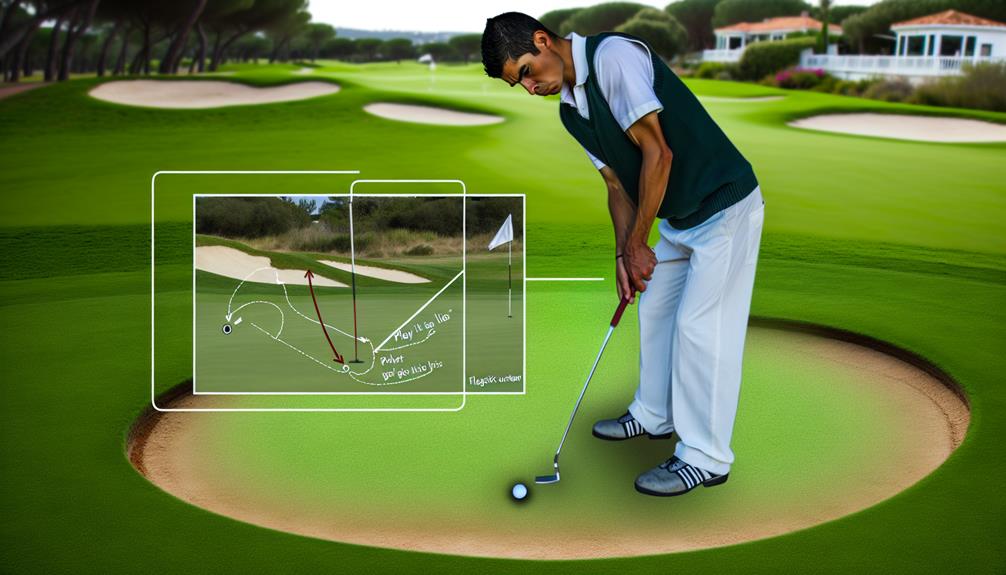Navigating the world of golf can feel like navigating a labyrinth, especially when it comes to understanding the basic putting rules. With finesse and precision, you're not just hitting a little white ball; you're entering a realm of strategy and technique. A mastery of putting can make or break your game.
From understanding the green and positioning yourself correctly, to handling the flagstick and knowing when a penalty might come your way, each aspect plays a pivotal role. And while we've just scratched the surface, there's a wealth of knowledge waiting to be unveiled as we delve deeper into each of these elements.
Understanding the Green in Golf
On the golf course, understanding the green is crucial to mastering the art of putting. The green is the heart of every golf hole; it's where you'll make your final strokes, and it's intricacies can significantly impact your score.
Green maintenance is a vital aspect to consider. You'll notice that the grass is mowed to a very short length. This is done to ensure a smooth roll for your golf ball. However, the direction of the grass growth, known as the grain, can affect the ball's speed and path. Paying attention to this can give you an edge on the putting green.
Putting surfaces aren't all created equal. Some are flat and straightforward while others are rippled and tilted, challenging your perception and skill. The speed at which a golf ball rolls on a green is known as the 'green speed,' and it can vary from course to course, even from hole to hole. It's your job to adapt to these variations.
Proper Positioning for Putting
Mastering the art of putting also necessitates perfecting your positioning, a crucial factor that can greatly influence your strokes' precision and power. Your feet should be shoulder-width apart, parallel to the target line. Your eyes should be directly over the ball, and your hands should fall naturally underneath your shoulders.
Grip techniques play a vital role in your positioning. One popular method is the reverse overlap grip. Here, your index finger of the left hand overlaps the fingers of your right hand, creating a solid connection. This technique offers control and stability, improving the accuracy of your shots.
Putter selection also significantly impacts your positioning. It's paramount to choose a putter that complements your stance and stroke style. The length of the putter should allow a comfortable, natural posture. If it's too long, you'll stand too upright, too short, and you'll crouch excessively, both affecting your stroke negatively.
The Rules of Striking the Ball
When it comes to striking the ball in golf, there are specific rules you must follow to ensure a fair and successful putt. Two key aspects you must consider are club selection and swing techniques.
Club selection is crucial. You can't just grab any club and expect a good shot. For putting, you should use a putter, which is specially designed for this purpose. It's designed with a flat face to help roll the ball along the green, rather than lift it into the air.
Your swing technique is equally important. Unlike other golf swings, the putting stroke should be more of a pendulum motion, with your shoulders doing the work and your wrists remaining still. You're not trying to smash the ball, but rather guide it smoothly towards the hole.
Handling the Flagstick Correctly
Just as important as mastering your swing and club selection, there's a proper etiquette to follow when dealing with the flagstick during a putt. Knowing your flagstick placement strategies is key. You can leave the flagstick in the hole, remove it, or have someone hold it, depending on your preference and the rules of the course. It's essential to communicate your choice with your fellow players to avoid confusion or violation of etiquette.
Flagstick related controversies often arise due to misunderstandings of the rules. For instance, under the new 2019 Rules of Golf, there's no penalty if your ball hits the flagstick left in the hole while making a stroke from the green. Previously, you'd incur a penalty for such an action. This change has sparked debates among players and spectators alike.
Handling the flagstick correctly is about more than just following the rules—it's about respect for the game and your fellow players. Remember, golf is a gentleman's game, and observing the proper etiquette, including correctly managing the flagstick, is an integral part of that tradition. So, study the rules, practice your strategies, and play with respect.
Penalties and Etiquette in Putting
Understanding the penalties and etiquette in putting is crucial, as any missteps can't only affect your score but also your standing with fellow players. When it comes to putting misplays, it's important to know the potential consequences. For instance, hitting the ball twice in one stroke, moving the ball by accident, or hitting the flagstick all result in a penalty.
Penalty avoidance is key to maintaining your score and reputation. Always ensure that the ball has come to a complete stop before making your next stroke. If you're unsure, it's better to wait a few more seconds than to risk a penalty.
Etiquette is another important aspect of putting. Be patient and always wait your turn. Avoid standing in a player's line of sight or casting a shadow on their line of play. Remember, it's not just about your game, it's about respecting the other players and the game itself.

